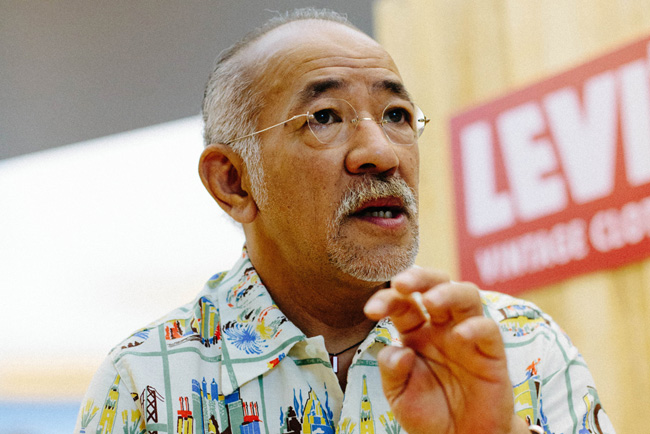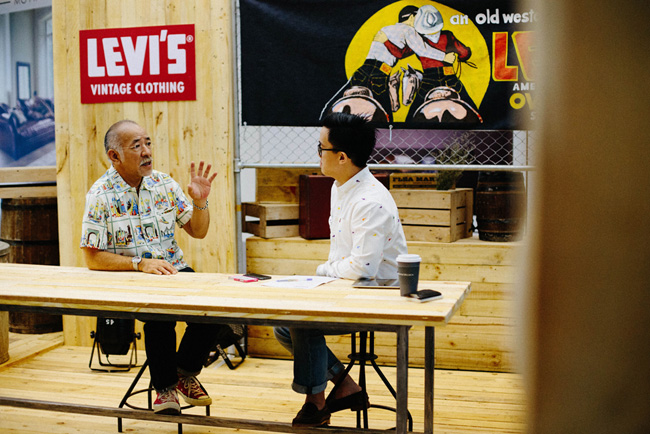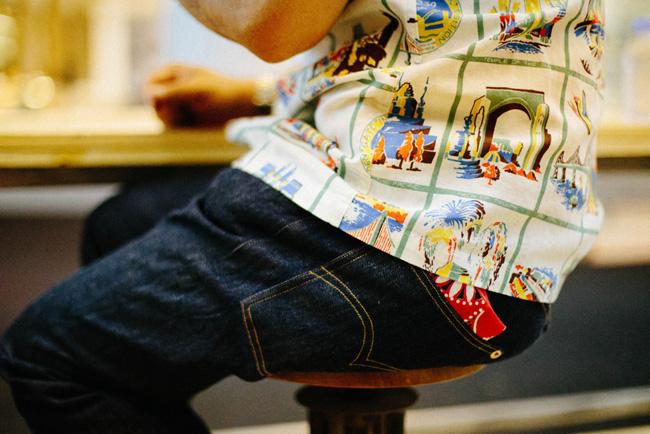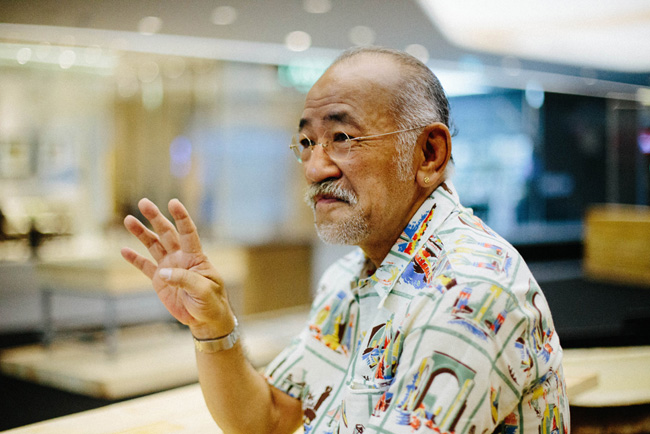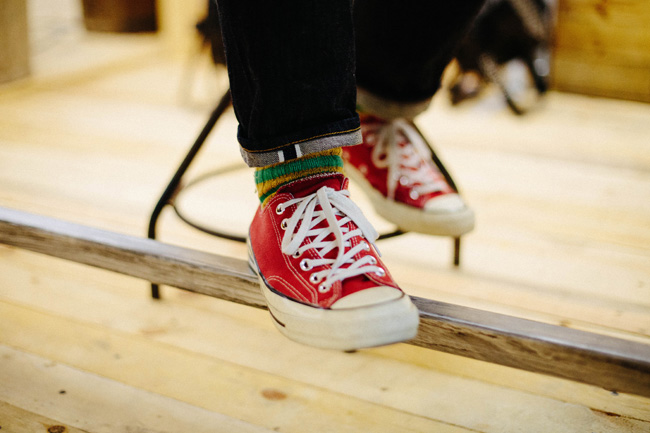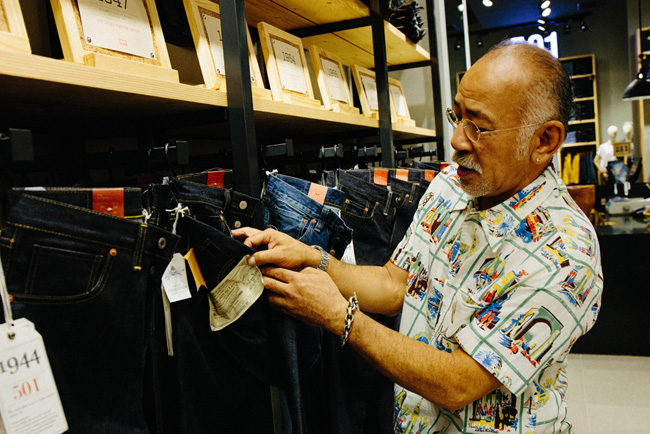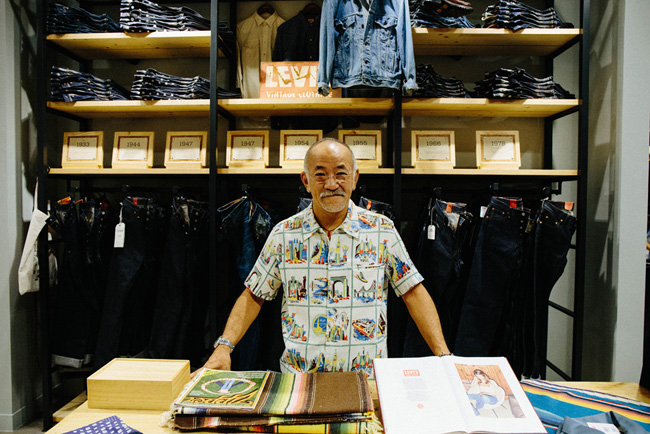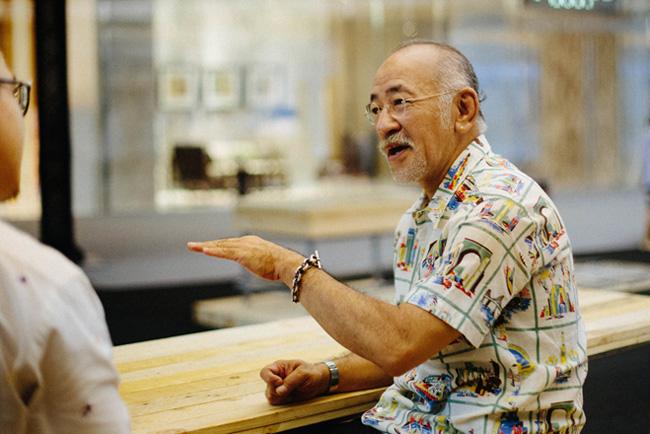
อยากให้ Mr. Yosuke แนะนำตัวเองให้กับผู้อ่านสักหน่อยครับ?
ครับ ผมชื่อ Yosuke Otsubo ผมเกิดและโตที่ญี่ปุ่น ตอนอายุยี่สิบต้นๆผมย้ายไปอยู่ L.A. เป็นเวลากว่า 29 ปี อายุ 50 ผมกลับมาอยู่ที่ Tokyo ก็นับรวมได้ 8 ปีละครับ ผมมีบ้านอยู่ทั้งสองที่ ตอนนี้ผมอาศัยที่ญี่ปุ่นเป็นส่วนใหญ่ ผมทำงานให้กับ Levi’s XX (ตำแหน่ง Regional Sales and Marketing Director Asia, Middle East, Africa) รับผิดชอบดูในส่วนของ Asia, Middle East และ Africa คุมเรื่อง Sales และ Marketing ให้กับ Levi’s Vintage Clothing (LVC) และ Levi’s Made and Crafted (LMC) ผมมีความสุขกับงานนี้มากๆ จะเรียกว่าเป็นงานในฝันผมเลยก็ว่าได้
คนส่วนใหญ่เข้าใจว่าคุณเป็นนักสะสมยีนส์ แต่ไม่ค่อยมีคนรู้มาก่อนเลยว่าคุณทำงานให้กับ Levi’s แถมเป็นตำแหน่งใหญ่อีกด้วย
หลายคนบอกว่าผมเป็นนักสะสมยีนส์ก็จริง แต่ผมไม่รู้สึกว่าตัวเองเป็นแบบนั้น นอกจากยีนส์แล้ว ผมชอบเสื้อผ้า ชอบแฟชั่น ชอบรองเท้า ชอบเครื่องประดับ นาฬิกาเก่า รถเก่า ของวินเทจ รวมถึงศิลปะ แต่ผมไม่อยากให้เรื่องพวกนี้มันให้ค่าจบแค่ที่ตัวสิ่งของ ผมเลยไม่อยากพูดว่าผมมีของสะสมกี่ชิ้น ชิ้นนั้นชิ้นนี้เป็นอะไร ความสุขของผมคือ การมีครอบครัวที่ดี มีเพื่อนที่ดี มีสุขภาพที่ดี กับเรื่องของสะสมถ้ามีมันก็คงดีมาก แต่ถ้าไม่มีผมก็ไม่เสียหายอะไร เอาล่ะกลับมาที่คำถามของคุณ ใช่ครับผมรักและชอบสะสมยีนส์ ถ้านับจากทั้งหมดที่กล่าวมา ยีนส์เป็นสิ่งที่ผมหลงใหลที่สุด ย้อนไปตั้งแต่ช่วงยุค 60’s 70’s ตอนนั้นผมอายุ 21 ไปอยู่ที่ Los Angeles ผมชอบเดินตามร้านเสื้อผ้ามือสอง แล้วก็เริ่มสังเกตเห็นว่า 501 ปี 1966 กับ 1978 มันไม่เหมือนกัน รายละเอียดเช่นตัวหมุดที่ต่าง สายรัดด้านหลัง และที่สำคัญคือสีน้ำเงินของแต่ละตัวนี่ยังไม่เหมือนกันเลย นั่นล่ะเป็นจุดที่ทำให้ผมเริ่มหลงรักยีนส์ ผมโชคดีที่ตอนผมเริ่มเก็บสะสม พวกยีนส์ยุคแรกๆยังราคาไม่แพงเท่าสมัยนี้ ช่วงปี 70’s 80’s ผมจะไปถอนเงินที่แบงค์ทุกๆเช้า แอบเก็บเงินใส่ถุงเท้า แล้วก็รอไปช็อปหาของ Deadstock (ของเก่ามือหนึ่งที่ร้านยังไม่เคยขายมาก่อน) ที่ผลิตในช่วง 1920’s 1950’s จากนั้นก็หิ้วกลับมาขายต่อให้ร้านในประเทศญี่ปุ่น ผมแนะนำให้พวกเขาลองเริ่มเอาของพวกนี้มาขาย ไม่นานคนก็เริ่มทำกันเยอะขึ้น เมื่อมีคู่แข่งเยอะ ผมก็หยุด จากวันนั้นผมก็ได้โอกาสมาทำกับ Levi’s กลายเป็นว่าทั้งอายุ 50 ปีผมพัวพันกับของวินเทจและเสื้อผ้ามาตลอดเลยจริงๆ ถ้าถามผม Levi’s คือเจ้าแห่งวินเทจ อย่างรุ่น 501 ที่มีแต่นักสะสมหลงใหล ต้องอย่าลืมว่าเขาคือแบรนด์ที่ทำกางเกงยีนส์ 5 กระเป๋าเป็นเจ้าแรกเลยนะ! เพราะฉะนั้นผมถึงบอกว่าการได้มีส่วนร่วมกับตำนานบทนี้ เป็นงานในฝันของผมเลยจริงๆ
อะไรคือความพิเศษหรือเสน่ห์ของยีนส์ โดยเฉพาะยีนส์ของ Levi’s?
เพราะ Levi’s มีประวัติศาสตร์ครับ และต้องบอกเลยว่าประวัติของ Levi’s มีมายาวนานมาก สามารถนับย้อนไปถึงตั้งแต่ต้นศตวรรษที่ 19 (1,800’s) ซึ่งถ้าเทียบในทุกวันนี้ Levi’s นอกจากมี Levi’s Vintage Clothing (LVC) ที่พูดถึงประวัติในอดีตเป็นเรื่องหลักแล้ว เรายังมี Levi’s Made and Crafted (LMC) อีกไลน์การผลิตที่เน้นในเรื่องการคราฟท์ แสดงถึงการที่เราไม่หยุดคิดค้นพัฒนายีนส์ในช่วง 100 ปีที่ผ่านมา เพราะฉะนั้นไม่ว่าคุณจะชอบความเก่าหรือความทันสมัย Levi’s ก็มีทั้ง LVC และ LMC ให้ตอบโจทย์ได้ทั้งสอง
มาพูดถึงคำว่า “วินเทจ” กันบ้าง หลายคนชอบบอกว่า วินเทจเริ่มต้นที่อเมริกา แต่เป็นชาวญี่ปุ่นที่เป็นคนให้ค่าและทำให้มันเป็นที่นิยมขึ้นมา คุณคิดยังไงกับคำกล่าวนี้?
ผมยังจำได้แม่นเลยว่าในปี 1975 สมัยนั้นถ้าคุณอยู่โตเกียว ก่อนที่จะมีร้าน Multi-Brand ในญี่ปุ่น (หรือที่เรียกกันว่า “Select Shop”) ถ้าจะมองหา Shop ของ Levi’s หรือเสื้อยืดสไตล์อเมริกันก็จะมีน้อยมากๆ ที่เดียวที่คุณจะหาซื้อเสื้อผ้าจากฝั่งอเมริกันได้คือ American Base Exchange เป็นร้านขายของผลิตอเมริกาและ Imported ส่งเข้ามา หลังจากนั้นพอนักลุงทุนเริ่มเข้ามาในตลาดนี้ เมื่อญี่ปุ่นเริ่มมีร้าน Multi-Brand กลยุทธ์การตลาดของพวกเขาก็คือนำเสนอวัฒนธรรม Culture ความเป็นอเมริกันหรือยุโรปจากโลกตะวันตกให้ผู้บริโภคส่วนใหญ่เข้าใจ ไม่นานคนญี่ปุ่นก็อินไปกับวัฒนธรรมเหล่านี้ มีหนังสือญี่ปุ่นที่พูดเรื่องแฟชั่นแบบตะวันตกเกิดขึ้น ทำให้คนหลงใหลว่าจะมีอะไรออกมาใหม่ อะไรคือ Movement ต่อไป แฟชั่นเทรนด์ตอนนี้คืออะไร ฉะนั้นกลับมาตอบคำถามที่ถามเอาไว้ครับ สิ่งที่ผมอธิบายมามันก็มีผลกับวัฒนธรรมวินเทจเช่นกัน ตามที่ผมบอกไปตอนต้นว่า ก่อนหน้าทุกอย่างคนญี่ปุ่นชอบเดินซื้อของตามร้าน Imported ของมือสองหรือของ Deadstock จากอเมริกันกันอยู่แล้ว ในสมัยนั้นมันยังไม่มีคำว่า Vintage เกิดขึ้นด้วยซ้ำ พวกเราคนญี่ปุ่นในเวลานั้นรู้แต่ว่า เรารู้สึกว่าของพวกนี้มันมีเอกลักษณ์ มันมีความเฉพาะตัวที่ไม่มีใครเหมือน และมันมีคุณค่า มีเรื่องเล่า น่าเก็บสะสม ไม่สามารถหาซื้อได้ตามร้านปกติทั่วไป แปลว่าเราให้ความสำคัญกับของวินเทจมาเป็นเวลากว่า 40 ปีแล้ว
จนถึงยุคสมัยนี้ ก็เป็นยุคที่เสื้อผ้าวินเทจมีอิทธิพลสำคัญในวงการแฟชั่นโลกเหมือนกัน?
ครับ ผมคิดว่าถุกต้องเลย ทุกวันนี้หลากหลายแบรนด์จากฝั่งอเมริกา และยุโรป ได้แรงบันดาลใจหลักของพวกเขามาจากเสื้อผ้าวินเทจ ผมจะยกตัวอย่างให้ฟังเรื่องนึง ผมรู้จักกับทีมงานที่คอยดูแลเรื่องเสื้อผ้าเก่าแก่และเก็บ Archives เป็นประวัติเอาไว้เลย สมมุติว่าดีไซน์เนอร์บอกว่า คอลเลคชั่นต่อไปคอนเซปต์เราจะเป็นภาพย้อนยุคของหญิงสาวสเปนอายุ 17 ปี กำลังล่องเรืออพยพไปอาเจนติน่า ทีมงานที่ว่านี้ก็จะคอยดูแลเรื่องนี้ก็ต้องพยายามนำเครื่องแต่งกายมาผสมกันให้ออกมาเหมือนในสตอรี่บอร์ดให้ได้ วินเทจมันคือสิ่งที่ทำให้เรามีแรงบันดาลใจในการผลิตผลงานใหม่ๆออกมาอย่างไม่ต้องสงสัยเลยครับ
ในมุมมองของคุณระหว่างอเมริกาและญี่ปุ่น มีวัฒนธรรมกางเกงยีนส์ที่แตกต่างกันอย่างไร?
ผมคิดว่าในโลกสมัยนี้ เมื่อเรามี Social Media เมืองแต่ละเมือง โดยเฉพาะเมืองใหญ่ๆหรือเมืองหลวงอย่างโตเกียว วัฒนธรรมโลกเริ่มค่อยๆหลอมรวมเป็นทิศทางเดียวกัน ซึ่งสิ่งที่ตอนนี้ผมเชื่อว่าผู้บริโภคกำลังมองหาอยู่คือไลฟ์สไตล์แบบแคลิฟอร์เนียหรือรัฐทางตอนใต้ เพราะท้ายที่สุดแล้วสิ่งที่สำคัญสำหรับกางเกงยีนส์คือความสะดวกสบาย ราคาจะแพงมากหรือน้อย เป็นวินเทจหายากหรือเปล่าอาจจะไม่สำคัญ สำหรับ Levi’s แล้ว ถ้าคุณใส่แล้วอยากนั่งบนถนน หรือนั่งบนหาดทราย หรือไปคอนเสิร์ต ไปมีนัดดินเนอร์กับคนสำคัญ ทุกอย่างมันยังคงอยู่ในคำว่าสะดวกสบาย มันเป็นกางเกงที่ตอบโจทย์ไม่ว่าไลฟ์สไตล์คุณจะเป็นแบบไหนก็ตาม คนที่เคยใส่ยีนส์ของเรา จะค้นพบเลยว่าสิ่งที่เรากำลังนำเสนอกับไลฟ์สไตล์ของพวกเขานั้นแยกกันไม่ออกเลย
เล่าให้เราฟังหน่อยได้ไหมว่าคุณมาทำงาน Levi’s ได้อย่างไร?
ประมาณ 6-7 ปีที่แล้ว เพื่อนสนิทคนเก่าคนแก่ของผม ทำงานเป็นตำแหน่งคอยดูแลรับผิดชอบอยู่กับแบรนด์ดังแบรนด์หนึ่งใน New York เขาอยากให้ผมไปเป็นคนดูแลแบรนด์ที่ว่านี้ในฝั่งทวีปเอเชีย ผมก็ตกลงนัด และก็ไปสัมภาษณ์งานกับคนใหญ่ๆในบริษัทเขา แล้วอยู่ดีๆวันนึงเขาก็โทรมาหาผมบอกว่า “โยสุเกะ นายไม่ต้องมา New York แล้วนะ เราไม่ต้องทำงานให้กับบริษัทนั้นแล้ว” ผมก็ตกใจถามกลับไปว่าทำไมล่ะ เขาเล่าต่อ “คือตอนนี้ ฉันออกจากงานเก่าแล้วล่ะ และกำลังจะไปทำให้กับ Levi’s เป็นโปรเจคต์ที่มีโค๊ดลับว่า Levi’s XX” ผมก็เลยถามเขากลับว่ามันคืออะไร “โอเค มันจะเป็นสิ่งที่ดีของดีที่สุด (Best of the Best) ที่เคยมีมาใน Levi’s Brand เราจะทำการ Re-Launch และทำคอลเลคชั่นใหม่ล่าสุดกัน นอกจากไลน์วินเทจ (LVC) แล้ว ยังมีไลน์ที่มีความโมเดิร์นร่วมสมัยอย่าง Made and Crafted (LMC) อีกด้วย” ไม่ถึงห้าวินาทีผมตอบกลับไปโดยไม่ต้องคิดเลยว่า “ตกลง” (หัวเราะ) นั่นล่ะครับเรื่องราวที่ผมได้เข้าทำงานที่นี่
ถ้า Levi’s Vintage Clothing (LVC) คือเรื่องของประวัติศาสตร์ แล้ว Levi’s Made and Crafted (LMC) ของพวกคุณกำลังพูดถึงเรื่องอะไร?
LMC เป็นตัวแทนฝั่งที่ “Modern” ของ Levi’s ครับ โมเดิร์นในที่นี้แปลว่า เรามีตลาดที่อายุกว้างขึ้น ถ้าเปรียบเทียบกับโลกของ LVC โลกของ LMC เราพูดถึงผู้คน ทั้งผู้ชาย ผู้หญิงเด็ก เราตั้งใจพูดกับวัยรุ่นรวมถึงวัยเริ่มเป็นผู้ใหญ่ (Young Adults) เน้นในเรื่องของการคราฟต์ผลงานที่กำลังเป็นเรื่องสำคัญในโลกสมัยนี้ เพราะฉะนั้นถ้าพูดถึงเรื่องความตอบโจทย์ผู้บริโภคในยุคสมัยนี้ ฝั่ง LMC จะมีความสนุกกว่า เราจะมีวิธีนำเสนอใหม่ๆ อย่างพยายามร่วมงาน Collaborate กับศิลปิน เป็นต้น ก็นับเป็นขั้นตอนที่น่าสนใจมากๆเช่นกันครับ
อะไรคือเบื้องหลังแนวคิดหลักในการคิดคอนเซปต์ต่างๆ?
กับ LMC เราพยายามคิดถึงเรื่องไลฟ์สไตล์ของคนใส่ เราไม่ได้พูดถึงแค่เรื่องราวหรือความเก่าแก่ของยีนส์อย่างเดียวแบบ LVC เพราะฉะนั้น LVC กับ LMC ถือว่าแตกต่างกันอย่างสิ้นเชิง เปรียบได้เหมือนน้ำกับน้ำมัน และสีขาวกับสีดำ ซึ่งผมเองมีหน้าที่ได้ดูแลทั้งสองไลน์นี้ก็กำลังมีความสุขกับมันเลยล่ะครับ เพราะถ้าชีวิตนี้ยังต้องวนเวียนอยู่กับคำว่า Vintage Vintage Vintage ใน LVC อย่างเดียว มันก็คงไม่สนุกน่ะสิ (หัวเราะ)
ดูคุณศึกษาเรื่องยีนส์มาเยอะขนาดนี้ อยากรู้ว่าทุกวันนี้คุณยังสามารถค้นพบดีเทลใหม่ๆที่เห็นบนกางเกงยีนส์และผลงานที่คุณทำอยู่ไหม?
ต้องบอกว่ามากที่สุดเลยครับ! เพราะผมยังคงรู้สึกดีเสมอๆเวลาที่ได้คุย ได้แลกเปลี่ยนความรู้กับบรรดานักสะสมคนอื่นๆ รวมถึงเวลาคุยกับดีไซน์เนอร์ที่หลายคนเขาไม่จำเป็นต้องชอบและคลั่งไคล้ของวินเทจเลยก็ตาม
แต่จากงานอีเวนท์ที่ผ่านมา สิ่งที่คุณพูดในงาน ทำให้รู้สึกเหมือนกับว่า คุณเคยรู้และเห็นหมดทุกอย่างแล้วจริงๆ!
ไม่หรอกครับ อาจจะเพราะว่าผมมีแหล่งความรู้ที่ดี ยกตัวอย่างผมมีเพื่อนที่ดีมากคนหนึ่ง เขารู้หมดเลยเกี่ยวกับเรื่องเส้นใย ตั้งแต่กรรมวิธีการผลิต ขั้นตอนและวัตถุดิบต่างๆ และแต่ละเรื่องมันมักจะเป็นอีกขั้นเลยกับเรื่องที่ควรจะรู้ในชีวิตคนปกติทั่วไป อย่างเรื่องแกะ เขามองแกะแต่ละตัว และเขาก็นึกตามว่า ในปีนึงขนบนตัวแกะสามารถทนอยู่กับอากาศที่แต่งต่าง 4 ฤดูกาลได้ โดนเฉพาะหน้าร้อนที่มีความชื้นสูง มันมีข้อดีข้อเสียอย่างไรที่สามารถนำมาปรับใช้กับการผลิต สิ่งเหล่านี้มันคือการศึกษาที่ลงลึกไปอีก เพื่อให้ได้ความรู้ที่มีประโยชน์กลับมา
ในมุมของคนที่ดูแลการตลาดของ Levi’s XX คุณคิดว่าตลาดใน Southeast Asia พร้อมสำหรับการมาถึงของ LVC และ LMC แล้วหรือยัง?
แน่นอนเลยครับ ถึงแม้ว่านี่เป็นครั้งแรกที่ผมเดินทางมาเยือนเมืองไทย แต่คนเล่นของวินเทจ นักสะสม บรรดาแฟชั่น Influencers ที่นั่นหลายคนพูดต่างถึงเรื่องเดียวกัน นั่นก็คือ “กรุงเทพ” แม้แต่เพื่อนผมบางคนที่เปิดร้านอาหาร คนพวกนี้ชอบไปปารีส มิลาน ตลอดเวลา เดี๋ยวนี้หันมาเป็นกรุงเทพกันหมดแล้ว ผมยังรู้มาว่าที่นี่มีการซื้อขาย Levi’s 501 รุ่นเก่า ตัวหายากมากๆระหว่างนักสะสมชาวไทยกันมากมาย ดูจากคนที่มาร่วมงานอีเวนท์ในวันนั้นก็สัมผัสได้แล้วว่ากรุงเทพพร้อมขนาดไหน สำหรับผมนี่คืออีกหนึ่งเมืองสำคัญที่มั่นใจว่า Levi’s มีฐานลูกค้าสูงมากๆเลยล่ะครับ
เวลาคุณทำงานกับ Levi’s ที่ทุกๆคนรู้ดีว่าคีย์เวิร์ดหลักคือเรื่องความคลาสสิค เรื่องของ Pattern รูปทรงและรายละเอียดการผลิตส่วนต่างๆต้องแม่นยำเหมือนกับที่ควรจะเป็น ในทางกลับกันทีมออกแบบคุณเดินไปพร้อมกันกับแฟชั่นทุกวันนี้ได้อย่างไร?
ผมพยายามคิดถึงลูกค้ามาก่อน เพราะเราต้องตอบให้ได้เสมอๆว่าลูกค้ากำลังมองหาอะไร ไม่ว่าจะเป็นนักสะสมกางเกงยีนส์ที่อยู่กับมันมาทั้งชีวิต หรือจะเป็นคนรุ่นใหม่ที่ชอบและกำลังเริ่มศึกษากางเกงยีนส์ 501 ของเรา หน้าที่ของผมและทีมเราคือต้องพยายามตอบคำถามและคิดให้เหมือนกับสิ่งที่ลูกค้าต้องการ เพื่อเป็นการใกล้ชิดกับพวกเขาให้มากที่สุด
แปลว่าพวกคุณไม่ได้ต่อต้านแฟชั่น?
ไม่ต้อต้านเลยครับ ยิ่งไปกว่านั้นผมเคารพสิ่งที่พวกเขาทำด้วยซ้า เพราะพวกเขาโลกถึงได้มีวัฒนธรรมใหม่ๆเกิดขึ้น และถ้าไม่มี Culture โลกก็คงไม่มีแฟชั่นเช่นกัน สิ่งที่ผมคิดก็คือผมมองว่าลูกค้าของเรา บรรดาคนแฟชั่นเข้าใจในสิ่งที่วงการนี้มันเป็น โอเคอันนี้เป็นเทรนด์ อันนี้เป็นคลาสสิค อันนี้เป็นงานแฟชั่นขั้นสูง พวกเขาสามารถแยกได้ เรื่องนี้ผมว่าไม่ต่างอะไรกับศิลปะเลย เรามีงาน Art อยู่บนโลกใบนี้มากมายก็จริง และความสนใจกระแสยุคต่างๆมันก็เปลี่ยนไปเรื่อยๆ คนดูงานก็เลือกรับได้ สิ่งที่เราต้องทำให้ได้คือ มีจุดยืนที่ชัดเจนและทำให้ลูกค้ามั่นใจกับผลงานของเรา
ยีนส์ที่ดี ในความคิดของคุณต้องเป็นอย่างไร?
อืม มันต้องเป็นยีนส์ที่ผลิตดีมีคุณภาพและสำคัญคือต้องดูดีเวลาที่คุณใส่มันด้วยเช่นกัน เท่านี้ก็พอแล้วครับ
มีคำแนะนำให้กับลูกค้าคนรุ่นใหม่ที่กำลังศึกษายีนส์? พวกเขาจะหายีนส์ที่เหมาะกับตัวเองได้อย่างไร?
อย่างแรกเลยผมอยากให้ทุกคนค้นพบยีนส์ที่เหมาะกับตัวเองที่สุดด้วยตัวเอง สุดท้ายแล้วทั้งหมดมันคือสิ่งที่ต้องใช้เวลาศึกษาด้วยตัวเอง เรื่องของโครงสร้างร่างกายของแต่ละคน ความสูง ความอ้วนผอม ไม่มีใครเหมือนใคร ซึ่งไม่ต้องกังวลเพราะ Levi’s มีเตรียมไว้รอหลายรุ่นหลายแบบมากมาย ขนาด 501 ของ LVC ยังแตกแยกออกไปเป็นปีต่างๆอีก ทางที่ดีที่สุดคือมาลองกางเกงที่ร้านของเรา แต่ถ้าคุณไม่มีเวลาจริงๆ คำแนะนำของผมคือ ถ้าเป็น LVC Made in USA ลองดูรุ่น 501 ปี 1947 มันเป็นทรงที่คลาสสิคตลอดกาล หรือสำหรับ LMC ลองซีรี่ส์ “Tack” ของเรา มันเป็นยีนส์ที่ออกแบบมาดีมากๆสำหรับผู้ชาย ถ้าอยากได้ความโมเดิร์น ใส่แล้วได้ลุคที่ดูสะอาดเป็นทางการ LVC รุ่น 606 ก็น่าจะเป็นทางเลือกของคุณ เป็นยีนส์ทรงกระบอกตรงที่เข้าพอดีกับขา เป็นกางเกงยีนส์ที่ใครต่อใครหลายคนใส่แล้วดูดีมากๆเลย ถ้าเจอรุ่นที่ถูกใจแล้ว อีกคำแนะนำของผมก็คือ ก่อนตัดสินใจซื้อพยายามลองยีนส์สองไซส์ก่อน ไซส์แรกคือไซส์ท่ีพอดีตัวคุณที่สุด และอีกไซส์นึงคือไซส์ที่หลวมขึ้นมาหน่อยอีก 1 หรือ 1/2 เบอร์ เพราะยีนส์เป็นกางเกงที่เวลาใส่ออกมาแล้ว ถึงแม้ไซส์ห่างกันนิดเดียว แต่ทรงของมันจะแตกต่างกันมากๆ แล้วแต่ว่าคุณจะชอบแบบไหนครับ
_________________________________________________
Can you please introduce yourself?
My name is Yosuke Otsubo, I was born and raised in Japan. When I was 21 I moved to Los Angeles and
lived there for 29 years. When I turned 50, I moved back to Tokyo and have been living there for the past 8 years now. I also have a house in Los Angeles, but I consider Tokyo to be my home. I work for Levi’s in the division called “Levi’s XX”, where I’m responsible for the parts in Asia, Middle East, and Africa. I also handle the sales and marketing for Levi’s Vintage Clothing and Levi’s Made and Crafted. I’m enjoying my work very much. It is my dream job.
People know you as a denim collector but not so many people know that you’re in charge of a very important job for Levi’s.
People may call me a denim collector, but I don’t consider myself that. I do love products, from clothes, fashion, denim, shoes, accessories, to vintage watches, vintage cars, potteries, and art. I think happiness has nothing to do with being materialistic, so I’d rather be discreet. I would rather not talk about how many vintage watches or how many vintage denims I own. The most important thing for me is, if my family is happy and healthy, and if I’m surrounded by good friends. But if I’m surrounded by my favorite things, that would make me even happier. So coming back to your question, yes I love denim. Fortunately, I had the opportunity to start collecting them early. Denim is one of my obsessed items, which I have worked with from the late ‘60s when I moved to Los Angeles at the age of 21. At the time, I was going through used clothes and discovered that there is a little difference between, let’s say the 501, the 1966 model or the 1978 model, that their hidden rivets, cinch backs, and how the blue denim gets personalized are all different. That was how I really became obsessed with denim. So I started to collect early era jeans, and I was able to acquire so many great pieces for a very cheap price. I was also a buyer for 3 years, from the late 70s to early 80s. I didn’t work for anybody back then. I went to the bank every morning, withdraw cash from my savings and hide the money in my socks and go shopping. I started to buy new-old stock from Denim and Co. dead stock, which were produced in the 1920’s, 1950’s, you name it. They have never been worn, so you can say that it’s a brand new merchandise. After doing that for many years, I started to buy and resell these items to Japanese retail stores. I suggested to them to start carry interesting old-but-new products. However, later on I started to see more competitors, so I stopped doing that and moved on to new clothing. I’m 50 years old, and I have been in the clothing business for my entire professional life. So I’m very happy that I started to collect Levi’s and denim from the 60’s. To me, the king of vintage is Levi’s, because the value of the 501 is quite a big statement. I mean, Levi’s is the pioneer of five pocket jeans! So for me to become a part of this brand is a dream job.
Can you tell us what is so special about this kind of garment, especially Levi’s?
Levi’s has a rich, rich history, which goes way back to the 1800’s. Not only do I love LVC (Levi’s Vintage Clothing), I also love Levi’s Made and Crafted (LMC), which is the modern side of Levi’s. We as a brand sees the importance of understanding and knowing what Levi’s has done in the past for the last 100 years, like utilizing the craftsmanship and their spirit to apply to Levi’s Made and Crafted. So we definitely have a rich history to introduce to our customers. It is very important for me to work with my colleagues for Levi’s Vintage Clothing, and Levi’s Made and Crafted, as our company needs to stay current and move forward.
Now let’s talk about vintage. Some say that vintage started from America, while the Japanese purified it. What is your opinion on that?
I can still clearly remember back in 1975, when I went to some of the interesting stores in Tokyo. That was before the Japanese business people started to offer to consumers the multi-brand store, which the Japanese now calls, ‘select shop’. Back then, all the consumers who really liked to dress different from the others had to go to American Base Exchange, where they had to go in and buy clothes that were made in America or imported from America. Also there weren’t many stores available for Levi’s, t-shirts, or anything from the United States. That’s why the Japanese started the multi-brand concept,and those pioneers were great at introducing new cultures from America, Europe, and elsewhere to the Japanese consumers. So soon after that, the consumers became so obsessed to be introduced to the new culture and lifestyle from the West. Then came the Japanese lifestyle and fashion magazines that started to introduce this new cultural trend. The consumers were so excited about what’s next, what’s new, and what the creative trend is. So to answer your question, the same thing goes to vintage culture. Back in the 70’s, there were people who started to import used clothes from America, but back then the word ‘vintage’ didn’t exist yet. So you see that it has been more than 40 years that consumers in Japan really understand how valuable these clothes are, how they are collectibles, and how it is cool to have one-of-a-kind, unique outfit that is hard to purchase among the other fashion brands or clothing brands.
And now vintage clothing plays an important role in the fashion industry?
I think so, yes. Many brands from Europe and America get their inspirations from vintage clothes. I know some very established archives service available. For example, some designers would say, next season our concept is about a Spanish lady, around 17 years of age, who is on a boat immigrating to Argentina. That’s the kind of concept the designers or merchandisers ask the archive service to put together, whether it’s the actual pieces of clothing or storyboards to help put together the collection. So I think vintage clothing is a great source to get inspiration from.
We know that Levi’s originated from San Francisco. What’s the difference between the culture of denim or jeans in the US and Japan, especially in vintage or crafted lines?
I think the major cities or the capital cities are becoming very close to each other, because of the social media. I think what the consumers are looking for is the Southern or Californian lifestyle, which is very casual and very comfortable when it comes to jeans. Of course, this doesn’t include the very expensive vintage jeans. For Levi’s jeans, if you want to sit down on the street, on the beach, or go to the concert or dinner at a nice restaurant, you can still be very comfortable, no matter what lifestyle you have. So by wearing our jeans, people will start to understand that the lifestyle we try to offer suits with their lifestyle.
So how did you started working with Levi’s?
About 6-7 years ago, one of my old friends who were responsible for a well-established brand in New York, asked me to be the responsible person for that brand in Asia. So I went to the interview with the key people there, and one day he called me, “Yosuke, don’t come to New York. Don’t work for the company.” I said, why? And he goes, “Well, I’m leaving for Levi’s. The project’s secret code is ‘XX’.” I asked him what that is, and he said, “Well, it’s going to be the best of the best Levi’s brand. It’s going to be re-launched and we’re putting together another brand new collection, a modern approach called ‘Made and Crafted.’” So in 5 seconds I said, “I’m in.” (laughs) So that was how I got hired.
If LVC is all about the history and bygone eras, what does LMC (Levi’s Made and Crafted) represents?
LMC represents being “modern”. Modern here means the wider age group compared to the vintage world of LVC. LMC is more about boys and girls, the young adults, and also respecting the craftsmanship that has continue to rise in the modern world. So the Levi’s Made and Crafted is more flexible when it comes to where and when people can wear our jeans. Also for every season, LMC collaborates with interesting artists. Lately we are working with American Quarterly magazine to put together a lookbook. Our designer will discuss with them to decide the concept, etc. It’s a very deep and interesting process.
So what is the philosophy behind this process?
The process is that we have to also think about the lifestyle for our consumers, not only about the jeans. We want our women and girls to look fabulous. It’s a different side compared to LVC. LVC and Made and Crafted are like oil and water, black and white. It’s the complete opposite, and I’m enjoying it because if I only stay with LVC, everything’s vintage, vintage, vintage. That’s not fun (laughs).
You know quite a lot about vintage and denim. As of today, do you still find new details or anything surprising in your work or about jeans?
Totally! It is always surprising to me when I talk to collectors or designers who don’t care about vintage.
But from the Levi’s Vintage Clothing Exhibition event, it sounds like you know and have seen everything already!
No, not really, maybe it’s because I have a good source. For example, I have a great friend who really knows how the fiber is twisted. It’s totally another level of understanding. Let’s say you look at a sheep, and you think, okay, sheep has fur for four seasons all year round. How can they be comfortable during the hot, humid summer? He’s the type of person who studies about fiber to invent new fiber.
Do you think countries in Southeast Asia or the Middle East are ready for the LMC and LVC market?
Of course, even though this is the first time for me in Thailand, many vintage clothing dealers to trendy fashion influencers I know, they all talk about Bangkok! Even my friends who own nice restaurants, those guys used to go to Paris or Milan all the time, now all come to Bangkok. Also, some of the most important, antique Levi’s 501 are often sold to collectors here in Bangkok. We can see that there are many great quality people who came to the Levi’s Vintage Clothing Exhibition event as well. So I can confirm that Bangkok is another important city where there are a lot of merchandise and where Levi’s consumers exist.
When you deal with Levi’s, especially how it stands for being the classic denim with very classic cut and silhouette, how serious is your team when talking about Levi’s in the fashion industry?
I think business wise, I always think about customers first, because we have to keep in mind what they are seeking for. My duty is to be close to the consumers from any segmentation. So either denim heads or very young potential consumers who could be the denim heads but right now doesn’t even know what 501 is, are all very important for me. So to be able to communicate and be close to the consumer is very important for me and my team.
So you don’t say that you’re against fashion?
I’m not against fashion or brand names. I personally respect them, because that’s how new cultures are created. Without the new culture, there’s no fashion. So I think the consumers or the people in the fashion industry understand that, okay, this is trendy, this is classic, this is sophisticated. I think it’s just like art. There are so much art available, and each consumers’ interests keep changing. But we need to be in the center to make sure our consumers feels confident with our product.
What is your definition of good jeans?
Well, it has to be very well made, and it has to look good when you put it on.
What’s your advice to the new buyers or consumers? How can they find the perfect jeans for themselves?
I want them to discover the silhouette that suits for them personally. It all depends on the person’s body structure, how tall or skinny they are. Levi’s has a lot to offer to our consumers. For example, we have so many varieties of the silhouette and details for LVC 501. We are always ready for the consumers to discover the best of the best jeans we have. Also, if they’re not so sure about the 501, we have the 606 that is straight, and slim where they can cuff it shorter, or if they’re looking for a very modern silhouette, then they can find that in Levi’s Made and Crafted. They just have to take some time and try them on. But if they’re too busy, I’d recommend the LVC made in USA rigid, 501, and 1947. As for Made and Crafted, try the Tack; it’s a really fantastic jeans for men. If they’re looking for a super modern, clean look, LVC 606 is to go for. It’s straight slim fit, many people look really good in it. I also suggest to at least trying two different sizes, the one that perfectly fits you, and another one that’s a bit looser. Who knows you might get two really good different looks.
Interview: Norrarit Homrungsarid
Photographer: Pakkawat Tanghom
English text: Thip S. Selley
Thai Translation: Pakkawat Tanghom
RECOMMENDED CONTENT
เป็นครั้งแรกที่บริษัทผู้สร้างตัวอักษรที่เก่าแก่ที่สุดอย่าง Monotype ได้ทำการออกแบบตกแต่งตัวชุดอักษรที่ใช้กันแพร่หลายทั่วโลกอย่าง Helvetica หลังจากที่พยายามปลุกปล้ำกันอยู่นานกว่าสองปีเพื่อที่จะปรับปรุงชุดตัวอักษรที่เป็นเอกลักษณ์ตามแบบ swizz font



